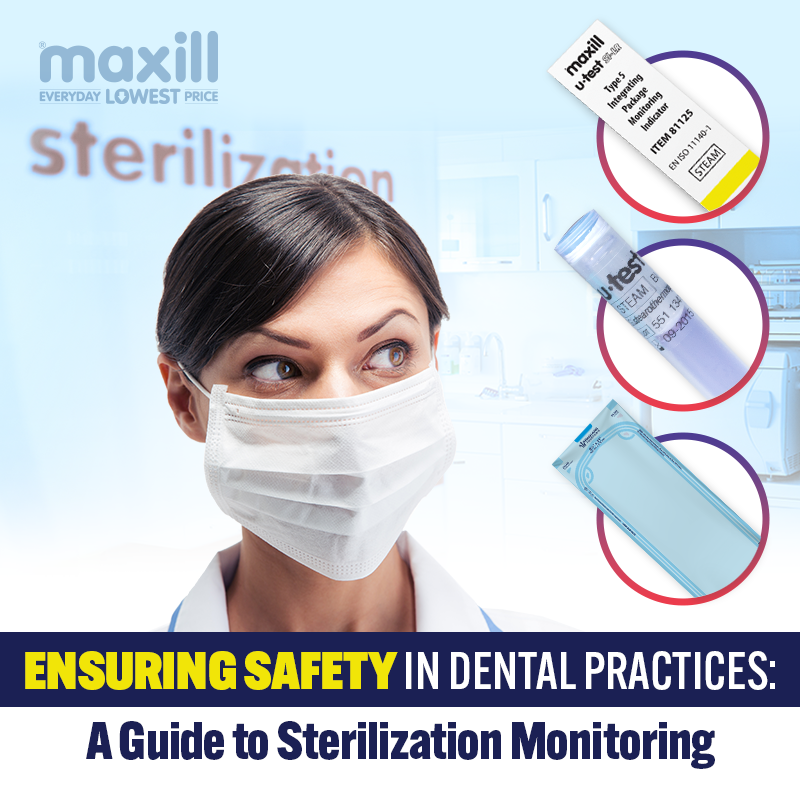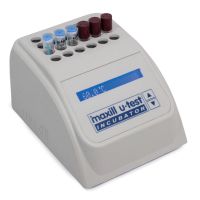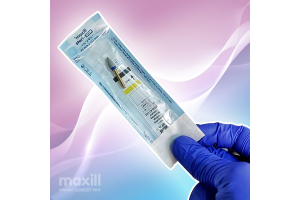Ensuring Safety in Dental Practices: A Guide to Sterilization Monitoring

Complete sterilization is critical in eradicating harmful microorganisms from equipment and instruments. Maintaining appropriate sterilization procedures in any dental practice will ensure the safety and health of patients and healthcare workers. But how can you tell if an instrument is properly sterilized? Using sterilization indicators is one way to evaluate whether instruments have been adequately processed before use. This article will explore the different types of sterilization indicators and the CDC and ADA guidelines for use in dental practices.
Is it Sterile?
It is impossible to tell if an instrument is truly sterilized by looking at the package. Sterilization equipment, such as an autoclave, may also fail, compromising the safety of the instruments. There are many reasons why sterilization may fail:
- Improper equipment maintenance
- A damaged gasket or seal on the door of the sterilizer
- Improper cycle time or cycle temperature
- Too many instruments in one package/pouch
- Too many packages in one cycle
- Inappropriate packaging material
- Multiple layers of packaging material
To achieve sterilization of instruments and equipment:
- Maintain sterilizing equipment and follow manufacturer's instructions for use.
- Do not overload the pouches or the sterilizer.
- Monitor the sterilization process with cycle indicators, chemical indicators, and biological monitoring on a routine basis.
- Document the monitoring to ensure quality control.
Sterilization Monitoring
The 2003 CDC Guidelines and the 2016 Summary are evidence-based sources for infection control practices in dental offices to protect workers and patients. One of the many recommendations includes key references for sterilizing semi-critical and critical patient care items that can encounter pathogenic microorganisms. According to the American Dental Association statement, which aligns with CDC recommendations:" Along with the proper sterilization of instruments, sterilizer monitoring is essential to any in-office infection control program."
Mechanical Indicators
A preliminary monitoring system uses mechanical indicators. These indicators record cycle time, pressure, and temperature. They can be found on the gauges and displayed during each load. Some newer sterilizers print out this information, which can be maintained and stored. Mechanical indicators should be recorded with each load to detect gross sterilizer malfunction or improper loading. It is essential to examine these readings at each cycle.
Chemical Indicators
Chemical indicators are defined by the Association for the Advancement of Medical Instrumentation (AAMI) as “sterilization process monitoring devices designed to respond with a chemical or physical change to one or more of the physical conditions within the sterilization chamber.” They monitor and identify that the packages within the sterilizer have been exposed to the proper sterilization atmosphere. Chemical indicators, such as indicator tape or color change dots on sterilization pouches, should be used on every package to verify that the sterilizing agent or process has penetrated the package and reached the instruments inside. Chemical indicators help to distinguish between processed and unprocessed items visually.
The CDC recommends that each package be immediately inspected when removed from the sterilizer; if the color change does not occur, do not use the instruments. The CDC does not recommend a specific type of chemical indicator. Single-parameter chemical indicators provide information from one parameter, such as temperature or time. Multiparameter chemical indicators are designed to determine exposure to two or more parameters, such as time and temperature or time, temperature, and the presence of steam. Another example of a chemical indicator is a Bowie-Dick* type, which checks for proper air removal of pre-vacuum steam sterilizers. No matter what chemical indicator is used, they do not confirm sterility or replace the need for weekly biological spore testing.
* Bowie-Dick Simulation Test Available on maxill Canada
Biological Indicators
The CDC recommends monitoring sterilizers at least weekly with biological indicators. Biological monitoring is the only method to verify sterilization. Biological indicators (BI) are either paper strips, glass, or plastic vials containing non-pathogenic, highly resistant bacterial endospores. When the sterilization process is successful, the dose of endospores is killed. The two types of bacterial endospores used are Geobacillus stearothermopohilus (for steam and unsaturated chemical vapor units) and Bacillus atrophaeus (for dry heat and ethylene oxide units).
Biological indicators are available as a mail-in or in-office incubator. The procedure for the mail-in system is after processing the BI paper strip with a normal load, the processed BI and the control (unprocessed) BI strips are both sent to a lab for incubation. The incubation results are sent back to the office by phone, fax, mail, or email. A much faster method is the in-office system. After processing, the test BI and an unprocessed control BI are incubated onsite. Results of the in-office system are available in 24-48 hours. This method avoids the time needed to send and the wait time to receive the results from mail-in systems, which can take up to 1 week.
A positive spore test result indicates that sterilization has failed. The CDC recommendations are:
- Take the sterilizer out of service.
- Review the sterilization process being followed in the office to rule out operator error as the cause of the failure.
- Correct any identified procedural problems and retest the sterilizer using biological, mechanical, and chemical indicators.
- The sterilizer can be returned to service if the repeat biological indicator test is negative and the other test results fall within normal limits.
- Maintain a log of spore test results. Check with your state board to determine how long you need to keep spore testing records.
What to Do When Results Confirm Sterilization Failure
If the repeat spore test is positive, the recommendations are:
- Do not use the sterilizer until it has been inspected or repaired or the exact reason for the positive test has been determined.
- Recall, to the extent possible, and reprocess all items processed since the last negative spore test. Keeping accurate records of the sterilization process will help to determine this.
- After the cause of the sterilizer failure has been determined and corrected and before placing the sterilizer back in service, the sterilizer must pass three consecutive empty chamber sterilization cycles using biological indicator tests.
Effective sterilization must occur before use for any instrument used in a dental practice to be safe. All instruments should be cleaned with detergents and water before sterilization, as this will remove any debris that could interfere with the process or cause damage. Furthermore, all instruments must be accompanied by an indicator showing when the sterilization process has been completed and is effective.
Conclusion
The CDC recommends that all dental professionals use biological indicators as their ultimate method of monitoring the effectiveness of their sterilization processes. These indicators vary depending on the type of sterilizer being used; however, they should always be comparable to biological indicators approved by the CDC. Knowing the differences between biological, mechanical, and chemical indicators, understanding the advantages of multivariable/multiparameter indicators, selecting a sterilizer that meets FDA guidelines, maintaining proper maintenance, and keeping accurate sterilization records are essential to successful implementation. Taking these factors into consideration will help ensure a safe environment for both practitioners and patients alike.












